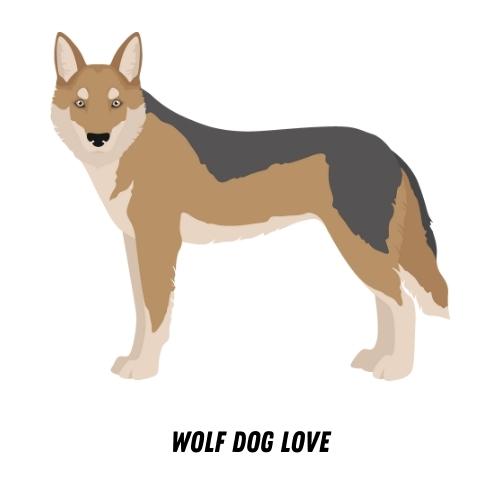Introduction to Understanding Wolf Dogs
Wolf dogs, a unique blend of domestic dog and wild wolf, are fascinating creatures. They carry the traits of both their canine and lupine ancestors, making them a subject of intrigue and sometimes, misunderstanding. This article aims to shed light on these remarkable animals, helping readers gain a deeper understanding of their traits and behaviors.
- Overview of the article: This comprehensive guide will delve into the world of wolf dogs. We will explore their distinct traits, understand their behaviors, and look at their natural instincts. We will also take a closer look at their characteristics through case studies, and conclude with key takeaways about their instinctual behavior. Our aim is to provide a well-rounded view of these animals, enabling readers to appreciate and understand them better.
- Importance of understanding wolf dog traits and behaviors: Wolf dogs are not your average pets. Their unique genetic makeup means they behave differently than typical domestic dogs. Understanding their traits and behaviors is crucial for anyone who lives with, works with, or is simply interested in these animals. It helps foster a healthy relationship between humans and wolf dogs, and ensures the wellbeing of these magnificent creatures. Knowledge about their behaviors can also dispel common myths and misconceptions, promoting a more accurate and respectful view of wolf dogs.
Whether you’re a wolf dog owner, a potential adopter, or an animal enthusiast, this article will provide valuable insights into the world of wolf dogs. So, let’s embark on this exciting journey to understand these unique creatures better.
Wolf Dog Traits: An Overview
Wolf dogs, as their name suggests, are a unique blend of domestic dog and wild wolf. This combination results in a fascinating creature with a mix of traits from both its canine and lupine ancestors. Let’s take a closer look at the physical characteristics and common personality traits of wolf dogs.
- Physical Characteristics of Wolf Dogs
- Common Personality Traits in Wolf Dogs
Wolf dogs are typically larger than most domestic dogs, with males reaching up to 180 pounds. They have a robust build, with a broad chest and strong, muscular legs. Their eyes are often a piercing yellow or blue, and their ears stand erect, similar to their wolf ancestors.
Their coat is usually thick and dense, providing them with excellent insulation in colder climates. Colors can range from white, grey, brown, and black, often with a mix of these shades. Their tails are bushy and usually hang down, unlike the curled tails seen in many dog breeds.
Wolf dogs are known for their intelligence and independence. They are often described as being more challenging to train than most domestic dogs due to their independent nature. However, with patience and consistency, they can learn and follow commands.
They are also known for their loyalty and protective nature. Once a wolf dog forms a bond with its human, it can be incredibly devoted and protective. However, they also have a strong prey drive and may not get along with smaller pets.
Wolf dogs are typically reserved and may be wary of strangers. They require plenty of socialization from a young age to ensure they grow up to be well-rounded and confident adults. Despite their reserved nature, they are usually not aggressive unless they feel threatened.
In conclusion, wolf dogs are a unique blend of wild and domestic traits. Their physical characteristics reflect their wild heritage, while their personality traits can be a mix of both wolf and dog. Understanding these traits can help potential owners provide the best care for these remarkable animals.
Understanding Wolf Dog Behavior
Wolf dogs, as the name suggests, are a unique blend of domestic dog and wild wolf. Understanding their behavior can be a fascinating journey. Let’s delve into some common wolf dog behavior patterns.
Wolf Dog Behavior Patterns
Wolf dogs exhibit a variety of behavior patterns that are a mix of both their wolf and dog heritage. Here, we will discuss two key aspects: how they communicate and some common behaviors and their meanings.
- How Wolf Dogs Communicate
- Common Behaviors and What They Signify
Wolf dogs use a combination of vocalizations, body language, and scent marking to communicate. They howl, growl, whine, and bark to express different emotions and intentions. Body language is also crucial. For instance, a raised tail often signifies dominance, while a tucked tail indicates submission or fear. Scent marking, through urination or defecation, is a way for wolf dogs to mark their territory.
Wolf dogs display a range of behaviors that can be intriguing to observe. Some of these include:
| Behavior | Significance |
|---|---|
| Pawing | This is often a sign of affection or a request for attention. |
| Howling | Howling can indicate loneliness, excitement, or a call to other pack members. |
| Growling | Growling is usually a warning sign of discomfort or aggression. |
| Chewing | Chewing can be a sign of boredom, anxiety, or teething in younger wolf dogs. |
Understanding these behaviors can help you better communicate with your wolf dog and meet their needs effectively.
Remember, every wolf dog is unique and may display different behaviors. Observing and understanding these behaviors is key to building a strong and respectful relationship with your wolf dog.
Instinctual Behavior in Wolf Dogs
Wolf dogs, a unique blend of domestic dog and wild wolf, exhibit fascinating instinctual behaviors. These behaviors, deeply rooted in their genetic makeup, include a strong prey drive and a complex system of hierarchy and territory establishment. Let’s delve deeper into these instinctual behaviors.
- Understanding prey drive and hunting instincts
Prey drive is a natural instinct in wolf dogs, inherited from their wolf ancestors. This instinct is a survival mechanism that drives them to hunt for food. When a wolf dog spots a potential prey, its hunting instincts kick in. It may begin to stalk, chase, and eventually attempt to capture the prey.
It’s important to note that this behavior doesn’t necessarily mean your wolf dog is aggressive. It’s simply a part of their nature. Understanding this can help you better manage your wolf dog’s behavior, especially around smaller pets and animals.
- How wolf dogs establish hierarchy and territory
Another instinctual behavior in wolf dogs is the establishment of hierarchy and territory. In the wild, wolves live in packs with a clear hierarchy. The alpha wolf is the leader, making key decisions for the pack and maintaining order. This hierarchical behavior is also seen in wolf dogs.
Wolf dogs also have a strong territorial instinct. They may mark their territory and can become protective of it. This behavior is usually more pronounced in male wolf dogs.
Understanding these instinctual behaviors can help you better understand your wolf dog and provide them with a suitable environment. Remember, these behaviors are a part of their nature and not something they can simply ‘unlearn’.
| Instinctual Behavior | Description |
|---|---|
| Prey Drive | A survival instinct that drives wolf dogs to hunt for food. |
| Hierarchy | A social structure where the alpha wolf dog leads and makes decisions. |
| Territory | A protective instinct where wolf dogs mark and defend their space. |
In conclusion, understanding the instinctual behaviors of your wolf dog can help you provide them with a more comfortable and suitable environment. It can also strengthen your bond with them as you learn to respect and accommodate their natural instincts.
Natural Instincts of Wolf Dogs
Wolf dogs, as their name suggests, are a mix of domestic dogs and wild wolves. This unique blend of genetics gives them a set of natural instincts that are fascinating to observe and understand. In this section, we will delve into the survival instincts of wolf dogs and how these instincts influence their behavior.
-
Survival Instincts in Wolf Dogs
Wolf dogs have a strong survival instinct, which is inherited from their wild wolf ancestors. This instinct includes a variety of behaviors that are designed to help them survive in the wild. For instance, wolf dogs are known for their exceptional hunting skills. They have a keen sense of smell and hearing, which they use to locate and catch their prey. They are also excellent diggers, a trait that helps them find food and create dens for shelter.
Wolf dogs also display a strong pack mentality. In the wild, wolves live and hunt in packs, and this behavior is also seen in wolf dogs. They are very social animals and often form strong bonds with their human families, viewing them as their pack. This pack mentality can lead to protective behavior, as wolf dogs will often go to great lengths to defend their pack members.
-
How These Instincts Influence Behavior
The survival instincts of wolf dogs greatly influence their behavior. Their hunting instincts, for example, can make them more likely to chase after small animals or objects. This can sometimes lead to problematic behavior in a domestic setting, such as chasing after cars or other pets.
Their digging instincts can also lead to behavior that is not always appreciated by their human families. For example, a wolf dog might dig up a garden or yard in search of food or as a way to create a den.
The pack mentality of wolf dogs can influence their behavior in a variety of ways. On the positive side, it can lead to strong bonds and loyalty towards their human families. On the other hand, it can also lead to protective and territorial behavior, especially if the wolf dog perceives a threat to its pack.
In conclusion, the natural instincts of wolf dogs are a fascinating blend of wild and domestic traits. Understanding these instincts can help us better understand and care for these unique and wonderful animals.
Wolf Dog Characteristics: A Closer Look
Wolf dogs, a unique blend of domestic dog and wild wolf, possess a fascinating array of characteristics. Let’s delve into their physical traits.
Physical Characteristics
Wolf dogs are known for their striking physical attributes. Here we will explore their size, build, coat colors, and patterns.
- Size and Build of Wolf Dogs
- Coat Colors and Patterns
Wolf dogs are typically larger than most domestic dogs, thanks to their wolf heritage. They can range in size from medium to large, with males often being larger than females. Their build is robust and muscular, designed for endurance and strength. They have a broad chest, long legs, and a straight tail. It’s important to note that the size and build can vary depending on the specific breed of dog in their lineage.
Wolf dogs have a dense double coat that comes in a variety of colors and patterns. The most common colors include white, black, gray, brown, and tan. Some wolf dogs may even have a combination of these colors. The coat pattern can also vary, with some having a solid color, while others may have a mix of colors, often in a mottled or brindle pattern. Their coat is designed to protect them from harsh weather conditions, much like their wild wolf ancestors.
Understanding these physical characteristics can provide a deeper insight into the unique nature of wolf dogs. Their size, build, and coat not only contribute to their stunning appearance but also play a crucial role in their survival and adaptability.
Behavioral Characteristics
Wolf dogs are unique creatures that exhibit a blend of behaviors from both wolves and domestic dogs. Let’s take a closer look at their social behaviors and common training challenges.
- Social behaviors of wolf dogs
Wolf dogs are highly social animals. They thrive in packs and establish a hierarchical order within their group. The alpha wolf dog leads the pack, making decisions about hunting and territory. This social structure is a key part of their survival in the wild.
Just like wolves, wolf dogs use a variety of vocalizations, body postures, and facial expressions to communicate with each other. They howl to assemble the pack, to pass on an alarm, or to locate each other during a storm or unfamiliar territory. They also show affection and submission through licking and tail wagging.
- Common training and behavior challenges
Training a wolf dog can be a challenging task. Their independent nature and high intelligence can sometimes make them stubborn and resistant to commands. They also have a strong prey drive and may chase smaller animals. It’s important to start training and socialization early to help them adapt to living with humans.
Wolf dogs also have a strong instinct to roam and may try to escape from enclosed areas. They require a lot of exercise and mental stimulation to prevent boredom and destructive behavior. It’s crucial to provide them with a secure and stimulating environment to meet their physical and mental needs.
Understanding and addressing these behavioral characteristics can help you build a strong and harmonious relationship with your wolf dog.
| Behavioral Characteristics | Explanation |
|---|---|
| Social behaviors | Wolf dogs are pack animals with a hierarchical social structure. They use various forms of communication such as howling, body postures, and facial expressions. |
| Training challenges | Wolf dogs can be stubborn and resistant to commands due to their independent nature and high intelligence. They have a strong prey drive and a tendency to roam, requiring early training, socialization, and a stimulating environment. |
Exploring Wolf Dog Nature: Case Studies
Let’s delve into the world of wolf dogs by examining two fascinating case studies. These studies will provide us with a deeper understanding of wolf dog behavior and the unique challenges and solutions associated with training them.
- Case study 1: Understanding wolf dog behavior through observation
- Case study 2: Training a wolf dog: challenges and solutions
In this study, a team of animal behaviorists spent six months observing a pack of wolf dogs in a controlled environment. They noted that wolf dogs exhibit a mix of traits from both wolves and domestic dogs. For instance, they observed that wolf dogs are highly intelligent and have a strong pack mentality, much like their wolf ancestors. However, they also display a level of friendliness and playfulness that is characteristic of domestic dogs.
One fascinating observation was that the wolf dogs displayed a high level of problem-solving skills. They were able to work together to solve complex tasks, such as figuring out how to open a complicated latch on a gate. This observation underscores the importance of mental stimulation in a wolf dog’s daily routine.
Training a wolf dog can be a challenging task due to their independent and stubborn nature. In this case study, a professional dog trainer shares his experiences and insights on training a wolf dog named Max.
Max was initially resistant to traditional training methods. However, the trainer found success by incorporating elements of play into the training sessions and by using positive reinforcement techniques. For instance, when Max successfully followed a command, he was rewarded with his favorite toy or a treat. This case study highlights the importance of patience, creativity, and a deep understanding of wolf dog behavior in training these unique animals.
These case studies offer valuable insights into the nature of wolf dogs. Understanding their behavior and training needs can help us provide them with a fulfilling and happy life.
Wolf Dog Instinctual Behavior: Key Takeaways
As we conclude our exploration of wolf dog behavior, it’s essential to highlight the key takeaways. Understanding and respecting the wild instincts of wolf dogs, as well as providing a suitable environment for them, are crucial steps in ensuring their well-being and happiness.
- Understanding and Respecting the Wild Instincts of Wolf Dogs
Wolf dogs are unique creatures that carry the traits of both domestic dogs and wild wolves. They have a strong instinctual behavior that is deeply rooted in their genes. It’s important to remember that these behaviors are not ‘bad’ or ‘wrong’ – they are simply a part of who the wolf dog is.
For example, wolf dogs have a natural instinct to roam and explore their surroundings, much like their wolf ancestors. They also have a strong prey drive, which can be triggered by smaller animals or fast-moving objects. Understanding these instincts can help you better manage your wolf dog’s behavior and meet their needs.
- How to Provide a Suitable Environment for a Wolf Dog
Providing a suitable environment for a wolf dog is another crucial aspect of their care. This means creating a living space that caters to their unique needs and instincts. For instance, wolf dogs require plenty of physical and mental stimulation to keep their active minds and bodies healthy. This can be achieved through regular exercise, play, and training sessions.
Moreover, wolf dogs need a secure and spacious outdoor area where they can safely explore and express their natural behaviors. This space should be securely fenced to prevent them from wandering off. Additionally, providing them with a variety of toys and enrichment activities can help satisfy their instinctual need to hunt and play.
In conclusion, understanding and respecting the wild instincts of wolf dogs, and providing them with a suitable environment, are key to their well-being. By taking these steps, you can ensure that your wolf dog lives a happy, healthy, and fulfilling life.
Conclusion: Embracing the Wild Within
- Summary of the Article
- Final Thoughts on Understanding and Living with Wolf Dogs
In this article, we’ve journeyed through the fascinating world of wolf dogs. We started with an introduction to understanding these unique creatures, examining their traits and behaviors. We delved into their natural instincts and took a closer look at their characteristics. Through various case studies, we explored the nature of wolf dogs, and highlighted key takeaways about their instinctual behavior.
Wolf dogs are not just pets; they are a blend of the wild and the domestic. Understanding and living with them requires patience, knowledge, and a deep respect for their wild instincts. They are not for everyone, but for those who are willing to embrace the wild within, they can be incredibly rewarding companions.
Remember, every wolf dog is unique, with its own personality and needs. It’s our responsibility as their human companions to provide them with the care, understanding, and environment they need to thrive. Embrace the wild within, and you’ll discover a bond that transcends the ordinary pet-owner relationship.








